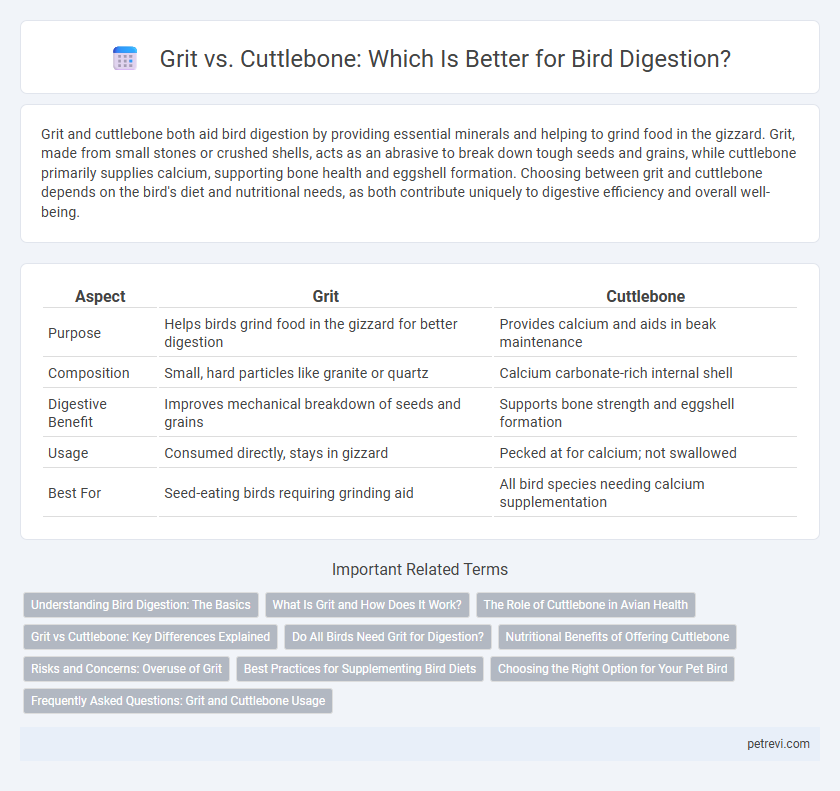Grit and cuttlebone both aid bird digestion by providing essential minerals and helping to grind food in the gizzard. Grit, made from small stones or crushed shells, acts as an abrasive to break down tough seeds and grains, while cuttlebone primarily supplies calcium, supporting bone health and eggshell formation. Choosing between grit and cuttlebone depends on the bird's diet and nutritional needs, as both contribute uniquely to digestive efficiency and overall well-being.
Table of Comparison
| Aspect | Grit | Cuttlebone |
|---|---|---|
| Purpose | Helps birds grind food in the gizzard for better digestion | Provides calcium and aids in beak maintenance |
| Composition | Small, hard particles like granite or quartz | Calcium carbonate-rich internal shell |
| Digestive Benefit | Improves mechanical breakdown of seeds and grains | Supports bone strength and eggshell formation |
| Usage | Consumed directly, stays in gizzard | Pecked at for calcium; not swallowed |
| Best For | Seed-eating birds requiring grinding aid | All bird species needing calcium supplementation |
Understanding Bird Digestion: The Basics
Grit and cuttlebone serve distinct roles in bird digestion by aiding the breakdown of food in the gizzard. Grit, composed of small, hard particles like sand or crushed stones, helps grind seeds and tough plant material, enhancing nutrient absorption. Cuttlebone, primarily made of calcium carbonate, supports not only digestion by providing essential minerals but also promotes healthy beak maintenance.
What Is Grit and How Does It Work?
Grit consists of small, coarse particles like sand or crushed stone that birds consume to aid in the mechanical breakdown of food within their gizzards. These abrasive materials grind seeds, grains, and other tough food items, enhancing nutrient absorption and supporting efficient digestion. In contrast, cuttlebone primarily provides calcium but does not facilitate the grinding process crucial for effective digestion.
The Role of Cuttlebone in Avian Health
Cuttlebone serves as a vital source of calcium, essential for strong eggshell formation and bone health in birds. It supports beak maintenance by providing a natural abrasive surface that prevents overgrowth and promotes proper wear. Unlike grit, cuttlebone primarily aids mineral supplementation rather than grinding food, making it indispensable for avian digestive and skeletal health.
Grit vs Cuttlebone: Key Differences Explained
Grit and cuttlebone serve distinct roles in bird digestion, with grit composed of small, hard particles like sand or crushed stone that aid in grinding food within the gizzard, while cuttlebone, derived from the internal shell of cuttlefish, primarily provides a natural source of calcium for bone strength and beak health. Grit enhances mechanical digestion by physically breaking down tough seeds and fibrous material, essential for species like pigeons and chickens, whereas cuttlebone offers essential minerals that support metabolic processes and eggshell formation. Understanding these differences helps optimize dietary supplementation, promoting overall avian health and efficient nutrient absorption.
Do All Birds Need Grit for Digestion?
Not all birds require grit for digestion; granivorous and herbivorous species typically benefit from ingesting grit to help grind seeds and plant material in their gizzards. Cuttlebone, primarily a calcium source, supports bone strength and egg production rather than aiding mechanical digestion. Birds such as parrots and finches often need grit, whereas many frugivores and nectarivores obtain sufficient digestive help without it.
Nutritional Benefits of Offering Cuttlebone
Cuttlebone provides essential calcium and trace minerals critical for bird bone health, eggshell strength, and overall metabolic function. Unlike grit, which primarily aids mechanical digestion by grinding food in the gizzard, cuttlebone delivers bioavailable nutrients that support feather development and prevent calcium deficiency disorders. Offering cuttlebone ensures birds receive a natural, continuous source of these vital minerals, promoting optimal physiological balance and longevity.
Risks and Concerns: Overuse of Grit
Excessive intake of grit can lead to digestive blockages and damage in birds, increasing the risk of impaction and internal injury. Unlike cuttlebone, which primarily provides calcium without abrasive properties, grit's abrasive nature can wear down the bird's digestive lining if overused. Monitoring grit consumption is essential to avoid mineral imbalances and maintain healthy digestion in avian species.
Best Practices for Supplementing Bird Diets
Grit and cuttlebone serve distinct roles in bird digestion, with grit aiding in the mechanical breakdown of food within the gizzard and cuttlebone providing essential calcium for bone health and eggshell formation. Best practices for supplementing bird diets prioritize offering insoluble grit for species that consume whole seeds and cuttlebone for calcium-dependent birds, ensuring appropriate size and quantity to prevent digestive issues. Regular monitoring of bird species-specific needs and dietary adjustments typically enhance nutrient absorption and overall digestive efficiency.
Choosing the Right Option for Your Pet Bird
Grit and cuttlebone serve different purposes in bird digestion, with grit aiding mechanical breakdown of food in the gizzard and cuttlebone providing essential calcium for bone health and eggshell formation. Selecting the right option depends on your bird species; granivorous birds like pigeons and quails benefit from grit to grind seeds, while parrots and other psittacines primarily require cuttlebone for calcium supplementation. Monitoring your bird's dietary needs and consulting avian nutrition guidelines ensures optimal digestive health and nutrient balance.
Frequently Asked Questions: Grit and Cuttlebone Usage
Grit and cuttlebone serve distinct functions in bird digestion, with grit aiding in grinding food within the gizzard and cuttlebone providing essential calcium for bone health and eggshell formation. Many bird owners frequently ask if their bird needs both grit and cuttlebone, as some species require grit for digestion while others benefit mainly from cuttlebone for mineral supplementation. Proper usage depends on the bird's natural diet and digestive system, making species-specific recommendations critical for optimal health.
Grit vs Cuttlebone for Bird digestion Infographic

 petrevi.com
petrevi.com